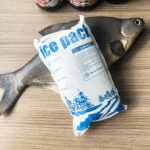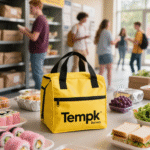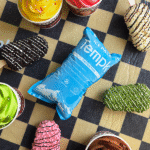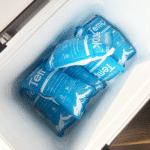عندما تحتاج إلى شحن اللقاحات, عينات من المأكولات البحرية أو المختبرية عبر دولة شاسعة مثل كندا, التحكم في درجة الحرارة غير قابل للتفاوض. صفائح الثلج الجاف في كندا توفير درجات حرارة شديدة البرودة باستخدام ثاني أكسيد الكربون الصلب (co₂) الذي يتسامى عند -78.5 درجة مئوية. على عكس عبوات الثلج أو الجل العادية, تحافظ هذه الأوراق على البضائع مجمدة لمدة 24– 72 ساعة دون إنتاج المياه الذائبة【270798852816686†L140-L139】. تشرح هذه المقالة كيفية عمل صفائح الثلج الجاف في كندا, كيفية حجمها والتعامل معها بأمان, وماذا 2025 الاتجاهات التي يجب أن تعرفها للحفاظ على سلامة شحناتك.
ما الذي يجعل صفائح الثلج الجاف في كندا فعالة? اكتشف علم التسامي وسبب أهمية درجات الحرارة شديدة البرودة.
كيف يمكنك تحديد حجم واختيار علبة الثلج الجاف المناسبة لشحنتك? تعلم صيغ الوزن, نسب الحمولة وآثار العزل.
كيف يمكنك استخدام صفائح الثلج الجاف في كندا بأمان وكفاءة? اتبع ممارسات التعبئة والتعامل خطوة بخطوة.
كيف يمكن مقارنة صفائح الثلج الجاف بحزم الهلام والمواد المتغيرة الطور (بي سي إم)? فهم نطاقات درجات الحرارة, المدة وإمكانية إعادة الاستخدام.
ماذا 2025 تؤثر الابتكارات واتجاهات الاستدامة على سلسلة التبريد في كندا? اكتشف التغليف الذكي, ثاني أكسيد الكربون المعاد تدويره والأنظمة الهجينة.
ما الذي يجعل صفائح الثلج الجاف في كندا فعالة جدًا?
التسامي ودرجات الحرارة الباردة جدا
تُصنع صفائح الثلج الجاف في كندا من ثاني أكسيد الكربون الصلب المضغوط الذي يتصاعد مباشرة إلى غاز عند درجة حرارة -78.5 درجة مئوية تقريبًا. وهذا يعني أنها تتجاوز المرحلة السائلة تماما, لذلك لا يوجد ماء يتسرب أو ينقع منتجاتك. يوفر الثلج الجاف درجات حرارة أكثر برودة ومدة أطول من عبوات الجل أو الثلج المائي, حفظ اللقاحات, البيولوجيا, المأكولات البحرية والعينات الجينية بأمان تحت عتباتها الحرجة. يمكن لصفائح الثلج الجاف عالية الجودة أن تحافظ على درجات الحرارة المتجمدة لمدة تصل إلى 72 ساعات【270798852816686†L140-L139】, تمكين الشحنات من عبور مسافات طويلة دون ذوبان الجليد.
عبوات الجل وثلج الماء تتجمد حولها 0 درجة مئوية. كما تذوب, فهي تطلق الرطوبة وتدفئها تدريجياً, مما قد يؤدي إلى تلف المنتجات أو الملصقات الحساسة. التسامي بالثلج الجاف يتجنب هذه المشاكل, تشكيل بطانية واقية من الغاز البارد حول البضائع الخاصة بك ومنع حرق الفريزر. للسلع التي تتطلب التبريد (2-8 درجة مئوية) بدلا من التجميد, تظل عبوات الجل مناسبة لأنها غير خطرة وأسهل في التعامل معها.
أنواع تنسيقات عبوات الثلج الجاف في كندا
تنسيقات مختلفة تناسب شحنات مختلفة. كتل أو ألواح (2-10 رطل) تسامى ببطء ويوفر القدرة على التحمل لمدة 24-72 ساعة. توفر أكياس الحبيبات تبريدًا سريعًا ولكنها تتسامى بسرعة, مما يجعلها جيدة لحاويات التكييف المسبق. تتميز الألواح المسجلة أو الألواح الصغيرة بالمرونة, مما يسمح لك بلف الثلج الجاف حول الأحمال غير المنتظمة دون إضاعة المساحة. يساعدك اختيار التنسيق الصحيح على إدارة معدل التسامي ومدة البرودة.
مقارنة وسائط التبريد
| وسط التبريد | تغيير المرحلة | نطاق درجة الحرارة | مدة نموذجية | الآثار العملية |
| الجليد الجاف (co₂) | يتسامى مباشرة من الصلب إلى الغاز | ≈ -78.5 درجة مئوية | 24-48 ح (حتى 72 ح مع أوراق ذات جودة عالية)【270798852816686†L140-L139】 | يوفر درجات حرارة شديدة البرودة دون بقايا سائلة; مثالية للقاحات, البيولوجية والأطعمة المجمدة. |
| حزم هلام | تذوب من الصلبة إلى السائلة | حول 0 درجة مئوية (32 ° f) | 6-24 ساعة | غير خطرة, قابلة لإعادة الاستخدام ومناسبة للمنتجات التي لا يجب تجميدها; مدة أقصر. |
| مواد تغيير المرحلة (بي سي إم) | انتقال الصلبة والسائلة في نقاط محددة | 2-8 درجة مئوية أو -20 درجة مئوية | 24-96 ح | قابلة لإعادة الاستخدام والتحكم الدقيق في درجة الحرارة; مثالية للسلع المبردة; سهولة الامتثال التنظيمي. |
كيفية تحديد الحجم واختيار أوراق حزمة الثلج الجاف من كندا لشحنتك
قواعد التحجيم العامة
إن تحديد حجم صفائح الثلج الجاف في كندا بشكل صحيح يضمن بقاء البضائع مجمدة دون إهدار مادة التبريد. القاعدة الشائعة هي استخدام 5-10 رطل (2.3-4.5 كجم) من الجليد الجاف لكل 24 ساعات العبور. للقاحات والمواد البيولوجية التي تتطلب درجات حرارة شديدة البرودة, استخدم الطرف العلوي من هذا النطاق; للوجبات المجمدة أو اللحوم, أقل قد يكون كافيا. هناك مبدأ توجيهي بسيط آخر وهو مطابقة وزن الثلج الجاف مع وزن المنتج لشحنات 48 ساعة, التكيف مع الموسم وتعقيد الطريق.
تؤثر جودة العزل بشكل كبير على متطلبات الثلج الجاف. يمكن أن يؤدي الترقية من رغوة EPS الأساسية إلى الألواح المعزولة بالتفريغ إلى تقليل احتياجات الثلج الجاف بنسبة 10-25 %. في الممارسة العملية, الحاويات ذات الجدران السميكة 2-3 بوصة تحافظ على البرودة لفترة أطول وتتطلب ثلجًا جافًا أقل من الصناديق الرقيقة. ابدأ بالصيغ العامة أدناه, ثم اضبطه بناءً على نوع الحاوية والظروف المحيطة.
وزن الثلج الجاف الموصى به حسب الحمولة والمدة
| وزن الحمولة | الجليد الجاف ل 24 ح | الجليد الجاف ل 48 ح | الجليد الجاف ل 72 ح | ماذا يعني هذا بالنسبة لك |
| 10 حمولة رطل | 5 رطل من الثلج الجاف | 10 رطل من الثلج الجاف | 15 رطل من الثلج الجاف | يكفي شحن اللقاحات أو عينات العلاج الجيني لمدة يومين. |
| 20 حمولة رطل | 10 رطل من الثلج الجاف | 20 رطل من الثلج الجاف | 30 رطل من الثلج الجاف | مناسبة للحوم المجمدة أو المأكولات البحرية لمدة تصل إلى ثلاثة أيام. |
| 50 حمولة رطل | 25 رطل من الثلج الجاف | 50 رطل من الثلج الجاف | 75 رطل من الثلج الجاف | تستخدم لشحنات اللحوم الكبيرة أو عمليات التسليم الصناعية. |
هذه الأرقام بمثابة نقاط البداية. زيادة المبلغ بنسبة 20-30 % خلال فصل الصيف أو عند الشحن عبر محاور متعددة, والتناقص بمقدار 10-25 % في حالة استخدام عزل عالي الأداء. يمكن أن يساعد اختبار الحزم المختلفة على أطول طريق في تحسين حساباتك.
توصيات محددة للمنتج
اللقاحات والمستحضرات البيولوجية شديدة البرودة: يستخدم 5– 10 رطل من الثلج الجاف يوميًا. الحفاظ على درجات الحرارة أقل من -70 درجة مئوية; إضافة وزن إضافي في المناخات الحارة.
المأكولات البحرية واللحوم الممتازة: 1– 2 رطل من الثلج الجاف يوميًا يكفي للشحنات الصغيرة; مضاعفة هذا للحاويات الأكبر.
الوجبات والحلويات المجمدة: 2– 3 رطل من الثلج الجاف يوميًا تحافظ على صلابة الوجبات المجمدة لمدة تصل إلى 72 ساعات.
استخدام الصيغ لتقدير الاحتياجات
صيغة بسيطة من شركات النقل اللوجستية هي:
الجليد الجاف (رطل) ≈ (وقت العبور بالساعات ÷ 24) × (متوسط الاستهلاك يوميا)
إذا كنت تخطط لشحن 36 ساعة وتحتاج 5 رطل يوميا للقاحات, الحساب هو (36/24) × 5 = 7.5 رطل. التقريب للأعلى يضمن وجود مخزن مؤقت. استخدم هذه الصيغة جنبًا إلى جنب مع الكتلة الحرارية لمنتجك وجودة العزل لتحديد حجم لوح الثلج الجاف بشكل صحيح.
التعامل الآمن والامتثال التنظيمي في كندا
التعامل مع الاحتياطات والتهوية
يعتبر الثلج الجاف آمنًا عند التعامل معه بشكل صحيح, ولكن سوء الاستخدام يمكن أن يسبب قضمة الصقيع, الاختناق أو انفجار الحاويات. قم دائمًا بارتداء القفازات المعزولة وحماية العين عند التعامل مع صفائح الثلج الجاف في كندا. لأن الثلج الجاف يطلق غاز ثاني أكسيد الكربون, العمل في منطقة جيدة التهوية أو تشقق نوافذ السيارة لتجنب إزاحة الأكسجين. لا تقم أبدًا بتخزين الثلج الجاف في حاويات محكمة الإغلاق أو مبردات محكمة الغلق; تسمح فتحات التهوية أو أغطية التهوية الذاتية للغاز بالهروب ومنع تراكم الضغط.
متطلبات التعبئة والتغليف ووضع العلامات
يصنف الثلج الجاف على أنه أ فصل 9 مواد خطرة للنقل الجوي. يجب أن تعرض الحزم الأمم المتحدة 1845 الماس الخطر وقائمة الوزن الصافي للثلج الجاف. لرحلات الركاب, يسمح اتحاد النقل الجوي الدولي (IATA) للمسافرين بحمل ما يصل إلى 2.5 كجم (5.5 رطل) من الثلج الجاف للشخص الواحد دون إعلان. الشحنات التجارية يمكن أن تحمل ما يصل إلى 200 كجم ولكن يجب أن تتبع قواعد التوثيق والتعبئة الصارمة. تواجه الشحنات البرية داخل كندا والولايات المتحدة قيودًا أقل ولكنها لا تزال تتطلب معالجة آمنة.
عند شحن المواد المعدية أو العينات البيولوجية, اتبع قاعدة التعبئة الثلاثية: وعاء أولي مانع لتسرب الماء, حزمة ثانوية مقاومة للماء تحتوي على مادة ماصة, وحاوية خارجية قوية. يجب أن تكون كل طبقة مقاومة للتسرب وأن تكون الحاوية الخارجية مُعلَّمة بوزن الثلج الجاف وتصنيف المخاطر.
التعامل مع أفضل الممارسات
ارتداء معدات الحماية: استخدام القفازات المعزولة, نظارات واقية وأكمام طويلة لتجنب قضمة الصقيع والحروق الباردة.
تهوية مساحات العمل: قم دائمًا بتوفير التهوية عند التعبئة, نقل أو تخزين الثلج الجاف.
شحنات التسمية: ضع علامة على العبوات بـ "الثلج الجاف" و"ثاني أكسيد الكربون"., صلب,” بما في ذلك الوزن الصافي والأمم المتحدة 1845.
قم بالتخزين بمسؤولية: احتفظ بالثلج الجاف في حاوية باردة أو معزولة تسمح للغاز بالهروب. تجنب العبوات الزجاجية أو البلاستيكية المغلقة التي قد تنفجر.
التخطيط لحالات الطوارئ: قم بتقديم تعليمات للتعامل مع قضمة الصقيع – اغمر المنطقة المصابة بالماء الدافئ واطلب المساعدة الطبية.
التعبئة والطبقات: كيفية استخدام صفائح الثلج الجاف من كندا بكفاءة
إجراءات التعبئة خطوة بخطوة
قم بتهيئة الحاوية مسبقًا: قم بتبريد صندوق التبريد أو المعزول الخاص بك قبل إضافة الثلج الجاف لإبطاء التسامي. إن وضع الثلج الجاف في حاوية دافئة يهدر طاقة التبريد.
إعداد وقطع الأوراق الخاصة بك: قم بترطيب صفائح الثلج الجاف (إذا لزم الأمر) وتجميدها بشكل مسطح. عندما تكون جاهزة, قم بقص الصفائح لتناسب الحاوية الخاصة بك باستخدام سكين مسنن أثناء ارتداء القفازات.
عزل الطبقة: ضع طبقة من الورق المقوى أو الرغوة في الجزء السفلي من الحاوية لمنع الاتصال المباشر بين الثلج الجاف ومنتجاتك.
ضع الثلج الجاف بشكل استراتيجي: إن وضع الثلج الجاف فوق البضائع الخاصة بك يسمح للهواء البارد بالهبوط ويضمن التبريد الموحد. للمنتجات التي لا يمكن تجميدها في الأعلى, يمكنك وضع الثلج الجاف في الأسفل والجوانب واستخدام حاجز لحماية البضائع.
ملء الفراغات: استخدم غلاف الفقاعات, رغوة أو شرائح ثلج جاف إضافية للتخلص من المساحة الفارغة. تقليل الفراغات يحسن الاحتفاظ بالبرد.
تنفيس وختم بشكل صحيح: أغلق الحاوية بشكل آمن ولكن اترك فتحات تهوية أو استخدم غطاء تنفيس ذاتي. استخدم الشريط اللاصق لتأمين الغطاء دون جعله محكم الغلق.
التسمية والوثيقة: قم بإرفاق الماس الخطر وقم بتضمين الوزن الصافي للثلج الجاف وإقرار الشاحن عند الحاجة.
أخطاء شائعة لتجنب
ختم الثلج الجاف في حاوية غير مهواة: هذا يمكن أن يسبب انفجار خطير.
التقليل من حدود الوزن: شركات الطيران تسمح فقط 2.5 كجم لكل راكب; قد تتطلب الشحنات الأكبر تصريحات خاصة.
باستخدام الصناديق العامة: تعمل الورق المقوى الرقيق أو الصناديق غير المعزولة على تسريع عملية التسامي والمخاطرة بفقد المنتج.
إهمال الكتلة الحرارية: تتطلب الحمولات الكبيرة كمية أكبر نسبيًا من الثلج الجاف; لا تفترض أن مقاسًا واحدًا يناسب الجميع.
مثال لحالة العالم الحقيقي
أ قامت شركة كندية للتكنولوجيا الحيوية بشحن لقاحات حساسة لدرجة الحرارة في جميع أنحاء البلاد باستخدام صفائح ثلجية جافة عالية الجودة في صندوق معزول محكم الغلق. تم وضع أوراق العبوة أعلى وأسفل القوارير, ومسجل بيانات يراقب الظروف الداخلية. حافظ هذا الإعداد على درجات حرارة أقل من -70 درجة مئوية لأكثر من ذلك 72 ساعات ومنع حدوث طفرات أثناء النقل, مما يوضح كيف يمكن للطبقات والمراقبة الدقيقة أن تحمي البضائع الحساسة.
كندا مقابل صفائح الثلج الجاف. عبوات الجل ومواد تغيير الطور
متى يتم استخدام كل مبرد
توفر عبوات الثلج الجاف درجات حرارة شديدة البرودة (أقل من -70 درجة مئوية) وهي مثالية للبيولوجيا المجمدة, منتجات العلاج الجيني, الآيس كريم والمأكولات البحرية. إنها توفر قدرة تبريد عالية مقارنة بالوزن ولا تترك أي بقايا سائلة. لكن, الثلج الجاف يستخدم لمرة واحدة ويتطلب وضع علامات على المواد الخطرة.
تحافظ عبوات الجل على درجات حرارة أعلى بقليل من درجة التجمد (حول 0 درجة مئوية) لمدة 6-24 ساعة, مما يجعلها خيارًا جيدًا للمنتجات الطازجة, منتجات الألبان أو الأدوية التي لا يجب تجميدها. إنها غير خطرة وقابلة لإعادة الاستخدام ولكنها قد تسرب الماء وتتطلب المزيد من العبوات لفترات أطول.
مواد تغيير المرحلة (بي سي إم) عقد نطاقات درجة الحرارة الضيقة, عادة 2-8 درجة مئوية أو -20 درجة مئوية, لمدة 24-96 ساعة. PCMs قابلة لإعادة الاستخدام وغير خطرة, تقديم مراقبة دقيقة وتبسيط الامتثال التنظيمي. يتم تعويض تكلفتها الأولية المرتفعة عن طريق التوفير على المدى الطويل وتقليل النفايات.
نظرة عامة مقارنة
| عامل | حزم الثلج الجاف | حزم هلام | بي سي إم |
| نطاق درجة الحرارة | بارد جدا (≈ -78.5 درجة مئوية) | قريب 0 درجة مئوية | 2-8 درجة مئوية أو -20 درجة مئوية |
| مدة | 24–72 ساعة[270798852816686†L140-L139] | 6-24 ساعة | 24-96 ح |
| فئة الخطر | فصل 9 خطرة; يتطلب وضع العلامات | غير خطرة | غير خطرة |
| إعادة الاستخدام | استخدام واحد; حاوية قابلة لإعادة الاستخدام | غالبًا ما تكون قابلة لإعادة الاستخدام ولكنها قد تتسرب | قابلة لإعادة الاستخدام للغاية |
| أفضل حالات الاستخدام | بيولوجيا شديدة البرودة, المأكولات البحرية المجمدة, بوظة | الأطعمة المبردة, الأدوية التي لا يجب تجميدها | اللقاحات, تتطلب البيولوجيا درجة حرارة ثابتة تتراوح بين 2-8 درجة مئوية أو -20 درجة مئوية |
النهج الهجين
للأحمال المختلطة, يمكن أن يؤدي الجمع بين عبوات الثلج الجاف وحزم الجل أو PCM إلى إطالة مدة التبريد وإنشاء مناطق متعددة درجات الحرارة. على سبيل المثال, يمكنك الحفاظ على ظروف شديدة البرودة للمواد البيولوجية في حجرة واحدة مع الحفاظ على العناصر الأخرى مبردة عند درجة حرارة 2-8 درجة مئوية. يقلل التغليف الهجين من إجمالي استهلاك الثلج الجاف ويخفف الأعباء التنظيمية, مما يجعلها مثالية للشحنات ذات متطلبات درجات الحرارة المتنوعة.
الاستدامة والاعتبارات البيئية
ثاني أكسيد الكربون المعاد تدويره والإنتاج الدائري
يؤدي تسامي الثلج الجاف إلى إطلاق غاز ثاني أكسيد الكربون, والتي يمكن أن تساهم في انبعاثات الغازات الدفيئة. يتم إنتاج معظم الثلج الجاف الصناعي من ثاني أكسيد الكربون المعاد تدويره والذي تم التقاطه خلال عمليات مثل تخليق الأمونيا وإنتاج الإيثانول.. تعمل إعادة التدوير على إعادة استخدام نفايات ثاني أكسيد الكربون وتجنب الحاجة إلى مصادر جديدة لثاني أكسيد الكربون تعتمد على الأحفوري, وبالتالي تقليل الأثر البيئي. عند اختيار الموردين, اسأل ما إذا كانوا يستخدمون مصدر حيوي أو ملتقط لثاني أكسيد الكربون. تستثمر صناعة الثلج الجاف في كندا في الإنتاج المحلي واحتجاز ثاني أكسيد الكربون لتقليل انبعاثات وسائل النقل وبناء مرونة العرض.
تقليل استهلاك الثلج الجاف
الاستخدام الفعال لألواح الثلج الجاف في كندا يقلل من التأثير البيئي. يمكن أن تؤدي ترقية العزل واستخدام العبوات الهجينة مع PCM إلى تقليل متطلبات الثلج الجاف بنسبة 10-25 %. قم بتحجيم العبوات بعناية وإضافة 5-10 رطل فقط لكل منها 24 ساعات- مع تعديلات الموسم وتعقيد المسار - يمنع إطلاق ثاني أكسيد الكربون الزائد. يمكن أن تساعد الآلات الحاسبة للثلج الجاف أو الأدوات التفاعلية العملاء على تقدير الكمية المناسبة, تقليل النفايات وتكاليف الشحن.
البدائل المستدامة والحلول الهجينة
التغليف المستدام يكتسب زخمًا 2025. الشركات المصنعة تتطور الشاحن الحراري القابل لإعادة التدوير وحزم الجل القابلة للتحلل. توفر المواد المتغيرة الطور تبريدًا قابلاً لإعادة الاستخدام دون تصنيف خطير وتوفر تحكمًا دقيقًا في درجة الحرارة. من خلال الجمع بين الثلج الجاف وPCM, يمكن للشاحنين تمديد وقت الانتظار, خفض انبعاثات ثاني أكسيد الكربون وتبسيط الامتثال.
ديناميكيات السوق وقيود العرض
يستمر سوق الثلج الجاف في النمو, لكن تقلبات العرض تظل مصدر قلق. نما الاستهلاك حوالي 5 % كل سنة, بينما زاد إنتاج ثاني أكسيد الكربون فقط 0.5 %, مما يسبب نقصًا عرضيًا وارتفاعًا في الأسعار. من المتوقع أن ينمو سوق الثلج الجاف العالمي من دولار أمريكي 1.54 مليار في 2024 إلى USD 2.73 مليار من قبل 2032, أ 7.4 % CAGR. تهدف الاستثمارات في مراكز الإنتاج المحلية وتكنولوجيا احتجاز ثاني أكسيد الكربون إلى استقرار العرض, ولكن لا يزال يتعين على العملاء التخطيط مسبقًا وتأمين العقود لضمان الوصول المستمر.
تطبيقات الصناعة ودراسات الحالة
قطاع الأدوية والتكنولوجيا الحيوية
اللقاحات, غالبًا ما تتطلب المواد البيولوجية ومجموعات التشخيص درجات حرارة أقل من -70 درجة مئوية. تعتبر صفائح الثلج الجاف في كندا ضرورية لشحن لقاحات mRNA ونواقل العلاج الجيني. وتستخدمها المختبرات أيضًا لنقل المواد الوراثية ومزارع الخلايا, ضمان بقائها مجمدة أثناء الأبحاث والتجارب السريرية. في مثال واحد, حافظت إحدى شركات التكنولوجيا الحيوية التي تقوم بشحن نواقل العلاج الجيني على درجات حرارة تتراوح بين -65 درجة مئوية و -70 درجة مئوية لمدة 72 ساعات عن طريق وضع كتل وكريات الثلج الجاف في حاوية مكيفة.
صناعة الأغذية والمشروبات
المأكولات البحرية, تعتمد منتجات الآيس كريم واللحوم على الثلج الجاف لتبقى مجمدة وتحافظ على جودتها أثناء النقل. إن نقص الماء الذائب في الثلج الجاف يمنع التغليف المبلّل. لشركات التجارة الإلكترونية التي تقوم بشحن الوجبات المجمدة عبر المناطق النائية في كندا, يسمح الثلج الجاف بالتسليم بدون شاحنات مبردة. استخدم أحد مصدري المأكولات البحرية صفائح الثلج الجافة بين المناشف الورقية المبللة لشحن الكركند الحي من كندا إلى اليابان; وصلت القشريات طازجة لأن الرطوبة ظلت منفصلة عن الجليد الجاف.
أبحاث الإلكترونيات والتكنولوجيا الحيوية
يمكن أن تتلف الأجهزة الإلكترونية الحساسة لدرجة الحرارة مثل أشباه الموصلات والرقائق الدقيقة بسبب الحرارة. تعمل صفائح الثلج الجاف على حماية هذه المكونات من خلال الحفاظ على الظروف شديدة البرودة. الكواشف التشخيصية, كما تستفيد عينات الحمض النووي والإنزيمات التي يتم شحنها لأغراض البحث من الثلج الجاف لأنها تتحلل بسرعة عند درجات الحرارة المرتفعة.
التجارة الإلكترونية وتسليم مجموعة الوجبات
مع توسع خدمات التوصيل للمنازل, يساعد الثلج الجاف في الحفاظ على جودة المنتج خلال الميل الأخير. تستخدم شركات أدوات الوجبات صفائح ثلج جافة صغيرة للحفاظ على وجبات الطعام عند -20 درجة مئوية 24 ساعات. إن إقران الثلج الجاف مع البطانات المعزولة بالتفريغ يضمن حصول العملاء على البضائع المجمدة حتى في المناطق النائية. قامت إحدى الشركات الناشئة بدمج آلة حاسبة للثلج الجاف في نظام الطلب الخاص بها; أدخل العملاء الموقع واختيار الوجبات وتلقوا اقتراحًا تلقائيًا لعدد عبوات الثلج الجاف المطلوبة, تقليل العوائد بسبب المنتجات المذابة 30 %.
البحث العلمي والفحوصات الطبية
تقوم المؤسسات البحثية والمختبرات الطبية بشحن عينات الدم, البلازما والعينات الأخرى على الجليد الجاف لمنع التدهور. يمنع البرد المستمر الإنزيمات من التحلل ويضمن نتائج اختبار موثوقة. قام مختبر أبحاث يقوم بشحن عينات جينية من فانكوفر إلى تورونتو بتسمية الحزمة بالفئة 9 الماس الخطر, أعلن عن وزن الثلج الجاف وفتحات التنفيس المستخدمة. نتيجة ل, وصلت الشحنة في الوقت المحدد وتجنبت الغرامات.
تحسين سلسلة التبريد الخاصة بك: النصائح وإطار اتخاذ القرار
استخدم التغليف والعزل عالي الجودة
العزل عالي الجودة هو أساس سلسلة التبريد المستقرة. يمكن للأكياس المعزولة المغلقة بالفراغ أن تحافظ على البرودة لمدة 48-72 ساعة, بينما توفر حاويات الستايروفوم 24-48 ساعة ويمكن أن تتجاوز الصناديق المعزولة الصلبة 72 ساعات. تعمل البطانات العاكسة والهوائيات الهوائية على تقليل اكتساب الحرارة وإطالة المدة. إن الاستثمار في التغليف عالي الجودة يؤتي ثماره عن طريق تقليل استهلاك الثلج الجاف ومنع التلف.
مراقبة درجة الحرارة في الوقت الحقيقي
استخدم مسجلات البيانات أو أجهزة استشعار إنترنت الأشياء لتتبع درجات الحرارة الداخلية أثناء النقل. ترسل الحزم الممكّنة لإنترنت الأشياء تنبيهات عندما تنحرف درجة الحرارة عن النطاق الآمن. يتيح لك ذلك التدخل بسرعة في حالة حدوث تأخيرات أو في حالة استهلاك الثلج الجاف بشكل أسرع من المتوقع. يوفر دمج أجهزة الاستشعار مع المنصات السحابية مراقبة مركزية عبر الشحنات.
خطط لطرق فعالة وعازل للتأخير
يؤدي التوجيه الفعال إلى تقليل وقت العبور والتعرض لدرجات الحرارة القصوى. العمل مع شركات النقل ذات الخبرة في التعامل مع المواد الخطرة والخدمات اللوجستية لسلسلة التبريد. إضافة أ 20-30 % هامش الأمان لكمية الثلج الجاف الخاصة بك لتغطية التأخير المحتمل. عندما تنطوي الشحنات على مناطق درجة حرارة متعددة, يضمن التغليف الهجين مع PCM بقاء كل منتج في النطاق المطلوب.
قائمة مراجعة اتخاذ القرار
تحديد متطلبات درجة الحرارة: اختر بين البرودة الشديدة (≥ -70 درجة مئوية), المجمدة (-20 درجة مئوية), مبردة (2-8 درجة مئوية) أو باردة (> 0 درجة مئوية) شروط.
تقدير مدة الشحن: إذا كان أقل من 72 ساعات, قد تكون عبوات PCM أو الجل كافية; وَرَاءَ 96 ساعات, الثلج الجاف ضروري.
ولنتأمل هنا التعقيد التنظيمي: إذا كنت ترغب في تجنب المعاملات الورقية الخاصة بالبضائع الخطرة, اختر حزم PCM أو هلام. إذا كنت بحاجة إلى ظروف شديدة البرودة, كن مستعدًا للامتثال للفئة 9 أنظمة.
تتماشى مع أهداف الميزانية والاستدامة: PCM القابل لإعادة الاستخدام له تكلفة أولية أعلى ولكن تكلفة عمر أقل; يتميز الثلج الجاف بتكلفة أولية أقل ولكن يجب تجديده في كل شحنة.
تقييم حساسية المنتج: حدد ما إذا كان منتجك يمكنه تحمل التجميد. بعض الأدوية أو الإلكترونيات لا تستطيع ذلك, لذلك قد تكون عبوات الجل أو PCM أكثر أمانًا.
الأدوات التفاعلية وإشراك المستخدم
فكر في إضافة أ حاسبة كمية الثلج الجاف إلى موقع الويب الخاص بك, السماح للمستخدمين بإدخال وزن الشحنة, نوع الحاوية, درجة الحرارة المحيطة ووقت العبور والحصول على توصية مخصصة. وهذا يقلل من التخمين, يعمل على تحسين مشاركة المستخدم وتقليل العائدات بسبب التعبئة الأقل أو الزائدة. يمكنك أيضا أن تقدم اختبارات التقييم الذاتي لمساعدة المستخدمين على تحديد ما إذا كان الثلج الجاف أو PCM هو الخيار الأفضل لمنتجاتهم.
2025 الاتجاهات والابتكارات في تكنولوجيا عبوات الثلج الجاف في كندا
صناعة سلسلة التبريد تتطور بسرعة, والبقاء على اطلاع يساعدك على البقاء قادرًا على المنافسة. وفيما يلي تشكيل التطورات الرئيسية 2025:
التغليف الذكي وأجهزة استشعار إنترنت الأشياء: مراقبة درجة الحرارة في الوقت الحقيقي ترسل الأجهزة المدمجة في العبوة تنبيهات عند انحراف درجات الحرارة, السماح بالتدخل الاستباقي.
إنتاج الثلج الجاف المستدام: يقوم المصنعون بالتقاط انبعاثات ثاني أكسيد الكربون الصناعية لإنتاج الثلج الجاف, تقليل البصمة البيئية. يستخدم بعض المنتجين ثاني أكسيد الكربون الحيوي الذي يتم التقاطه أثناء تخمير الإيثانول.
الأتمتة والكفاءة اللوجستية: تعمل الروبوتات وخطوط التعبئة الآلية على تحسين وضع صفائح الثلج الجاف وتقليل الأخطاء البشرية. تساعد البرامج اللوجستية على التنبؤ بالتوجيه الأمثل وجدولة عملية إعادة التجهيز.
حلول الثلج الجاف الهجين PCM: يؤدي الجمع بين الثلج الجاف وPCM إلى إنشاء مناطق درجات حرارة متعددة وإطالة مدة التبريد, تقليل استخدام ثاني أكسيد الكربون.
مواد العزل المتقدمة: الهلاميات الهوائية, تعمل ألواح العزل الفراغي والطلاءات العاكسة على تحسين الأداء الحراري وتقليل وزن العبوة.
نمو السوق وتفضيلات المستهلك: من المتوقع أن يشهد سوق المبردات سلسلة التبريد نمواً قوياً تنمو من $1.69 مليار في 2025 ل $2.92 مليار من قبل 2032. يطالب المستهلكون بالاستدامة والشفافية, دفع الشركات إلى الكشف عن مصادر ثاني أكسيد الكربون والاستثمار في الحلول الصديقة للبيئة.
مرونة سلسلة التوريد: استهلاك الثلج الجاف يتزايد في جميع أنحاء 5 % كل سنة, بينما ينمو إنتاج ثاني أكسيد الكربون فقط 0.5 %, مما تسبب في نقص في بعض الأحيان. يقوم المصنعون ببناء مراكز إنتاج إقليمية ويلتقطون الانبعاثات لتأمين الإمدادات.
الأسئلة المتداولة
س 1: ما المدة التي تدوم فيها صفائح الثلج الجاف في كندا؟?
يمكن لألواح الثلج الجاف عالية الجودة أن تحافظ على برودة البضائع 24-72 ساعة, اعتمادا على الكمية المستخدمة, جودة العزل ودرجة الحرارة المحيطة. تستمر الكتل عادة من 24 إلى 48 ساعة, بينما يمكن للأوراق تمديد المدة إلى 72 ساعات.
Q2: ما هي القاعدة العامة لتحديد حجم الثلج الجاف بالنسبة لوزن المنتج؟?
المبدأ التوجيهي المشترك هو 5– 10 رطل من الثلج الجاف لكل 24 ساعات أو أ 1:1 نسبة وزن الثلج الجاف إلى وزن المنتج لشحنات 48 ساعة. اضبط بإضافة 20-30 % أكثر للطقس الحار أو الطرق المعقدة.
س 3: هل يمكنني إعادة استخدام صفائح الثلج الجاف في كندا؟?
لا. يتسامى الثلج الجاف تمامًا, لا تترك شيئا لإعادة استخدامه. لكن, يمكن إعادة استخدام العبوة الخارجية والعزل. للتبريد القابل لإعادة الاستخدام, ضع في اعتبارك عبوات PCM أو الجل, والتي يمكن إعادة تجميدها.
س 4: هل من الآمن التعامل مع صفائح الثلج الجاف؟?
نعم, إذا تم التعامل معها بشكل صحيح. استخدم دائمًا القفازات والنظارات الواقية المعزولة, العمل في منطقة جيدة التهوية, ولا تضع الثلج الجاف في حاوية محكمة الإغلاق أبدًا. يجب أن يتسرب غاز ثاني أكسيد الكربون لمنع الاختناق أو الانفجار..
س 5: هل يمكنني دمج الثلج الجاف مع عبوات الجل أو PCM?
قطعاً. تعمل الأنظمة الهجينة على تمديد مدة التبريد وإنشاء مناطق درجات حرارة متعددة. عبوات جل بطيئة التسامي بالثلج الجاف, بينما يوفر PCM درجات حرارة متوسطة مستقرة.
س6: ما هي اللوائح التي تحكم شحن الثلج الجاف في كندا?
الجليد الجاف هو أ فصل 9 مواد خطرة ويجب أن يكون مكتوبًا عليه "الثلج الجاف" أو "ثاني أكسيد الكربون"., الصلبة" والوزن الصافي. يسمح اتحاد النقل الجوي الدولي (IATA) بما يصل إلى 2.5 كجم لكل راكب دون إعلان, بينما يمكن للشحنات التجارية أن تحمل ما يصل إلى 200 كجم. تواجه الشحنات البرية قيودًا أقل ولكنها لا تزال تتطلب معالجة آمنة.
س7: كيف يمكنني تقليل الأثر البيئي لاستخدام الثلج الجاف?
مصدر الثلج الجاف المصنوع من ثاني أكسيد الكربون المعاد تدويره أو الملتقط حيويًا, استخدم فقط ما تحتاجه, وتبني الحزم الهجينة مع PCM لتقليل إجمالي استهلاك الثلج الجاف. إعادة تدوير أو إعادة استخدام المواد العازلة وتثقيف المتلقين بشأن التخلص السليم منها..
ملخص وتوصيات
توفر صفائح الثلج الجاف في كندا أداءً فائق البرودة لا مثيل له, حفظ الشحنات مجمدة لمدة تصل إلى 72 ساعات دون ترك بقايا الماء. إنها تعمل عن طريق تسامي ثاني أكسيد الكربون الصلب عند -78.5 درجة مئوية, تقديم مستمر, التبريد الجاف الذي يحمي اللقاحات, البيولوجيا, المأكولات البحرية والإلكترونيات. لحجمها بشكل صحيح, يستخدم 5-10 رطل لكل 24 ساعات أو مطابقة وزن الثلج الجاف مع وزن الحمولة. قم بترقية العزل وفكر في استخدام العبوات الهجينة باستخدام PCM لتقليل الاستهلاك بمقدار 10-25 %. تعامل دائمًا مع الثلج الجاف بالقفازات, توفير التهوية والامتثال للوائح. مع تزايد الطلب, اتجاهات الاستدامة, و 2025 الابتكارات - مثل أجهزة استشعار إنترنت الأشياء وإنتاج ثاني أكسيد الكربون المعاد تدويره - تظل صفائح الثلج الجاف في كندا أداة مهمة للحفاظ على سلاسل التبريد.
نصيحة قابلة للتنفيذ
قم بتقييم احتياجات درجة حرارة منتجك واختيار المبرد المناسب (الثلج الجاف للبرودة الشديدة, عبوات جل مبردة, PCM للتحكم الدقيق).
حساب كمية الثلج الجاف باستخدام الصيغ المقدمة, إضافة مخزن مؤقت للتأخير.
تحضير وتعبئة بعناية: حاويات ما قبل التبريد, عزل الطبقة, ضع الثلج الجاف بشكل صحيح وقم بتهوية الحاويات.
استخدام تسجيل البيانات وأجهزة الاستشعار لمراقبة الشحنات وضبط العبوات في الوقت الحقيقي.
اختر الخيارات المستدامة: كن شريكًا مع الموردين الذين يستخدمون ثاني أكسيد الكربون المعاد تدويره ويدمجون PCM أو التغليف القابل لإعادة التدوير.
تثقيف فريقك والعملاء حول التعامل مع الثلج الجاف بأمان والتخلص منه بطريقة مسؤولة.
حول Tempk
Tempk هي شركة متخصصة في تعبئة سلسلة التبريد ومقرها كندا ومعروفة بأكياس الثلج الجاف عالية الجودة, حزم هلام, الصناديق المعزولة والحاويات الذكية. إن تركيزنا على الاستدامة يعني أن العديد من منتجاتنا مصنوعة من معاد تدويرها ومصممة لتقليل التأثير البيئي. نحن نخدم الأدوية, التكنولوجيا الحيوية, قطاعات الأغذية والتجارة الإلكترونية, توفير حلول التعبئة والتغليف التحقق من صحتها, الخبرة التنظيمية وتكنولوجيا المراقبة في الوقت الحقيقي. اتصل بخبرائنا لاستكشاف ألواح الثلج الجاف في كندا وحلول سلسلة التبريد المخصصة التي تحافظ على سلامة شحناتك, متوافقة وصديقة للبيئة.
























